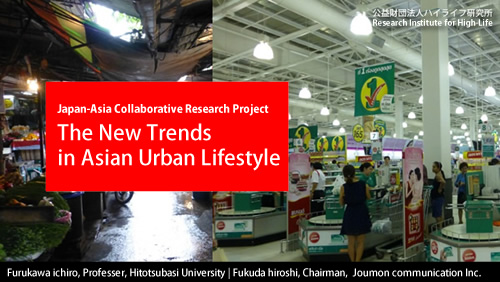Manila | Part1 Mall culture and brand awareness among the socioeconomic classes in Metro Manila
Japan-Asia Collaborative Research Project
Study report "The New Trends in Asian Urban Lifestyle"

"The New Trends in Urban Lifestyle in Manila" (serial in 4 parts)
Part 1 Mall culture and brand awareness among the socioeconomic classes in Metro Manila
Carlos Luis L. Santos, Japanese Studies Program
Ateneo de Manila University.
Summary
Republic of the Philippines is a young and energetic country with a population of about hundred million people, whose average age is 23. The island country has a land area of about 0.3million km2 (around 80% of that of Japan) and comprises 7019 islands. Its capital city Metro Manila is one of the largest cities in the world with a population of approximately 20 million people and has good transportation to other Asian major cities. In 2012 the country achieved a nominal GDP of about 250.3 billion dollars and 6.6% of real GDP growth rate. Metro Manila has started to see newly emerging middle classes and diversified lifestyles. In accordance with such situation, the capital is transforming itself into a comfortable global city by urban development.
However, the images of the Philippines introduced to Japan are mainly negative ones such as poor security, unsafe, wide economic gap, frequent terrorist attacks and social disturbance.
As a matter of fact, the real Philippines have very different aspects. On spiritual foundation of Catholics, the people take care of their family, and are optimistic and tolerant toward outer worlds. Though there are some poverty issues, the citizens enjoy active consumption in the energetic city. In some sense, the Philippines are an attractive country of mixed and complicated foreign cultures that can’t be measured by single standard, both for the economy and the society.
Part 1 introduces history of the country and its economic situation, and focuses on shopping malls that make a part of Metro Manila citizens’ life of all income classes to show actual conditions of their everyday life.


Principal Author Carlos Luis L. Santos
Lecturer:Japanese Studies Program
Ateneo de Manila University
Education:2009-present: MA in Japanese Studies, Ateneo de Manila University
2009: Translation and Business Japanese course, Philippine Institute of Japanese Language and Culture
2008: Intensive Japanese Language Course, Philippine Institute of Japanese Language and Culture
2007: Bachelor of Arts in Communication, Minor in Japanese Studies, Ateneo de Manila University
Work experience:2010 present: Japanese Language Instructor, Ateneo de Manila University
2010-2012: Translator/Basic Japanese Instructor, MHI Technical Services, Inc.
2009: Scholarship Assistant, Japan Information and Culture Center, Embassy of Japan in the Philippines
Research interests:Translation, Sociolinguistics, Comparative Culture
Co-Researcher:
Furukawa Ichiro, Professer, Hitotsubasi University
Fukuda hiroshi, Chairman, Joumon communication Inc.
Editing and Delivery Public-Interest Incorporated Foundation
Research Institute for High-Life http://www.hilife.or.jp/
Study report "The New Trends in Asian Urban Lifestyle"

"The New Trends in Urban Lifestyle in Manila" (serial in 4 parts)
Part 1 Mall culture and brand awareness among the socioeconomic classes in Metro Manila
Carlos Luis L. Santos, Japanese Studies Program
Ateneo de Manila University.
Summary
Republic of the Philippines is a young and energetic country with a population of about hundred million people, whose average age is 23. The island country has a land area of about 0.3million km2 (around 80% of that of Japan) and comprises 7019 islands. Its capital city Metro Manila is one of the largest cities in the world with a population of approximately 20 million people and has good transportation to other Asian major cities. In 2012 the country achieved a nominal GDP of about 250.3 billion dollars and 6.6% of real GDP growth rate. Metro Manila has started to see newly emerging middle classes and diversified lifestyles. In accordance with such situation, the capital is transforming itself into a comfortable global city by urban development.
However, the images of the Philippines introduced to Japan are mainly negative ones such as poor security, unsafe, wide economic gap, frequent terrorist attacks and social disturbance.
As a matter of fact, the real Philippines have very different aspects. On spiritual foundation of Catholics, the people take care of their family, and are optimistic and tolerant toward outer worlds. Though there are some poverty issues, the citizens enjoy active consumption in the energetic city. In some sense, the Philippines are an attractive country of mixed and complicated foreign cultures that can’t be measured by single standard, both for the economy and the society.
Part 1 introduces history of the country and its economic situation, and focuses on shopping malls that make a part of Metro Manila citizens’ life of all income classes to show actual conditions of their everyday life.

Principal Author Carlos Luis L. Santos
Lecturer:Japanese Studies Program
Ateneo de Manila University
Education:2009-present: MA in Japanese Studies, Ateneo de Manila University
2009: Translation and Business Japanese course, Philippine Institute of Japanese Language and Culture
2008: Intensive Japanese Language Course, Philippine Institute of Japanese Language and Culture
2007: Bachelor of Arts in Communication, Minor in Japanese Studies, Ateneo de Manila University
Work experience:2010 present: Japanese Language Instructor, Ateneo de Manila University
2010-2012: Translator/Basic Japanese Instructor, MHI Technical Services, Inc.
2009: Scholarship Assistant, Japan Information and Culture Center, Embassy of Japan in the Philippines
Research interests:Translation, Sociolinguistics, Comparative Culture
Co-Researcher:
Furukawa Ichiro, Professer, Hitotsubasi University
Fukuda hiroshi, Chairman, Joumon communication Inc.
Editing and Delivery Public-Interest Incorporated Foundation
Research Institute for High-Life http://www.hilife.or.jp/